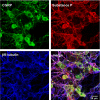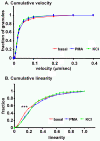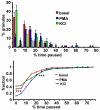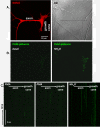Dynamics of peptidergic secretory granule transport are regulated by neuronal stimulation
- PMID: 20202202
- PMCID: PMC2838897
- DOI: 10.1186/1471-2202-11-32
Dynamics of peptidergic secretory granule transport are regulated by neuronal stimulation
Abstract
Background: Peptidergic neurons store and secrete the contents of large dense core vesicles (LDCVs) from axon terminals and from dendrites. Secretion of peptides requires a highly regulated exocytotic mechanism, plus coordinated synthesis and transport of LDCVs to their sites of release. Although these trafficking events are critical to function, little is known regarding the dynamic behavior of LDCVs and the mechanisms by which their transport is regulated. Sensory neurons also package opiate receptors in peptide-containing LDCVs, which is thought to be important in pain sensation. Since peptide granules cannot be refilled locally after their contents are secreted, it is particularly important to understand how neurons support regulated release of peptides.
Results: A vector encoding soluble peptidylglycine alpha-hydroxylating monooxygenase fused to green fluorescent protein was constructed to address these questions in cultured primary peptidergic neurons of the trigeminal ganglion using time lapse confocal microscopy. The time course of release differs with secretagogue; the secretory response to depolarization with K+ is rapid and terminates within 15 minutes, while phorbol ester stimulation of secretion is maintained over a longer period. The data demonstrate fundamental differences between LDCV dynamics in axons and growth cones under basal conditions.
Conclusions: Under basal conditions, LDCVs move faster away from the soma than toward the soma, but fewer LDCVs travel anterograde than retrograde. Stimulation decreased average anterograde velocity and increases granule pausing. Data from antibody uptake, quantification of enzyme secretion and appearance of pHluorin fluorescence demonstrate distributed release of peptides all along the axon, not just at terminals.
Figures









References
-
- Takamori S, Holt M, Stenius K, Lemke EA, Gronborg M, Riedel D, Urlaub H, Schenck S, Brugger B, Ringler P, Muller SA, Rammner B, Grater F, Hub JS, De Groot BL, Mieskes G, Moriyama Y, Klingauf J, Grubmuller H, Heuser J, Wieland F, Jahn R. Molecular anatomy of a trafficking organelle. Cell. 2006;127:831–846. doi: 10.1016/j.cell.2006.10.030. - DOI - PubMed
-
- Mains RE, Eipper BA. In: Basic Neurochemistry, Molecular, Cellular and Medical Aspects. 7. Siegel GR, Albers W, Brady ST, Price DL, editor. New York: Elsevier; 2006. Peptides; pp. 317–332.
-
- Kaether C, Salm T, Glombik M, Almers W, Gerdes HH. Targeting of green fluorescent protein to neuroendocrine secretory granules: a new tool for real time studies of regulated protein secretion. Eur J Cell Biol. 1997;74:133–142. - PubMed
Publication types
MeSH terms
Substances
Grants and funding
LinkOut - more resources
Full Text Sources
Molecular Biology Databases

